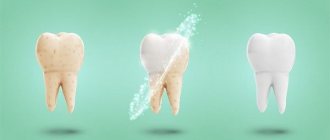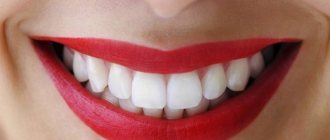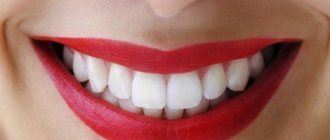A beautiful, white smile and an even row of teeth make your interlocutor feel better and attracts glances. All this cannot be achieved if you do not monitor the health of your teeth and oral cavity. Modern medicine offers patients a range of services to restore the beauty of their teeth, including fluoridation.
Fluoride is a natural substance that is also found in many components, including water. This product is actively added to toothpastes and various products for cleaning the oral cavity and preventing diseases.
In this article we will look at what fluoridation is and the effects of fluoride on teeth.
What is fluoridation?
Fluoridation is a way to strengthen tooth enamel, give it a more attractive appearance and protect it from caries. The procedure involves the use of special products, for example, varnishes, foams or gels, in which the amount of fluoride is much higher than in regular toothpastes.
Fluorine and fluorides
Fluorine in its pure form is a yellowish gas with a characteristic pungent odor. It is poisonous, so it should be used with extreme caution in domestic conditions. Among all the elements of the periodic table, it is one of the most chemically active. Compounds of fluorine with other substances are called fluorides: there are a huge number of them, so their areas of application are also very extensive. This includes dentistry. The first pastes containing fluoride appeared at the beginning of the twentieth century, and in the late 1940s, an experimental program for water fluoridation began in the United States, which brought mainly positive results in the fight against caries. After some time, several dental associations of the leading countries of the world recognized fluoridated toothpastes as an effective preventive measure. At the same time, the number of opponents of fluoride increased, including quite well-known specialists.
Attention!
Toothpastes and other oral care products use fluoride rather than fluoride itself.
Mechanism of fluoridation
To understand the meaning of using fluoride, it is necessary to understand a little the structure of tooth enamel. The main inorganic components of enamel are compounds collectively called apatites. These apatites come in two types: calcium-containing and fluorine-containing. Most of the enamel contains calcium compounds, but fluoride compounds are much more resistant to acids. Throughout human life, the surface layers of enamel are destroyed. Thanks to the fluoride contained in saliva, these layers are restored. It should be noted that we are talking about microscopic quantities; visible enamel defects are not restored. Thus, the amount of stable fluoride compound in the enamel increases. If a person has problems with salivation, there is not enough fluoride in food and drinking water, the inorganic part of the enamel is damaged, and holes appear in the teeth. Fluoridation of teeth is a good way to increase the amount of fluorapatite and strengthen tooth enamel . Such teeth are more resistant to organic acids produced by bacteria.
Why do they argue about the benefits and harms of fluoride?
The main reason for the controversy is the properties of fluorine and compounds based on it. Let's start with the fact that without a minimum amount of this substance in the body, the normal development of not only teeth, but also nails, hair and skeletal bones as a whole is impossible. Fluorides are found in most foods and even the earth's crust, so we get some portions of it anyway. Most experts and scientists agree that for an adult the daily fluoride intake should be 3-5 mg, and for children - from 0.5 to 2 mg (depending on age). The deficiency leads to accelerated demineralization of enamel and the formation of caries, osteoporosis and other problems that go far beyond the oral cavity.
On the other hand, a few grams of fluoride in its pure form are considered fatal to humans, and a regular overdose can cause problems with bones and joints, liver, heart, respiratory system and provoke a number of diseases. Most dental patients are interested in the harm of fluoride to teeth when using special toothpaste and drinking fluoridated water. It so happens that they are the ones who most often become the subject of the most heated debates and the basis for the emergence of myths and prejudices.
Fluorides in food
Technology and stages of fluoridation
Before any fluoridation - deep or superficial, using varnish, foams, gels - it is necessary to first clean the surface to be treated. Therefore, the patient undergoes professional oral hygiene: plaque and stones are removed. The drug applied to an uncleaned surface will not give results. If the doctor uses gel or foam, they usually come in individual application trays. These trays are filled with a solution, and the patient remains in them for approximately 3-5 minutes while the teeth are saturated with fluoride. The varnish is applied in a thin layer to the tooth and waited for two minutes, then the patient rinses his mouth, and a protective film is formed on the surface of the teeth. During deep fluoridation, two components are used; they are applied layer by layer in two stages. The first is a magnesium-fluoride solution, the second is copper-calcium hydroxide. The duration of deep fluoridation of teeth is about an hour; you will need to visit a doctor 3-4 times. As for the effectiveness of the process, it can be argued that all methods are equally good and teeth will be perfectly protected after fluoridation.
The benefits and harms of fluoride in toothpaste
You need to understand that fluorine in this case is a generalized concept. For example, toothpaste does not contain fluoride itself in its primary state, but compounds based on it. Most often it contains the following types of fluorides:
- Sodium monofluorophosphate
is practically absent in modern pastes due to the slow release of fluoride ions. - Sodium fluoride
is a very popular component, which is characterized by fast action and good remineralizing properties. By the way, most opponents of fluoridation talk about the harm specifically from sodium fluoride. - Stann fluoride
is another fairly common ingredient used by several major toothpaste manufacturers. - Aminofluoride
is considered the most modern, effective and expensive type of fluoride in oral care products.
Conversations about the benefits and harms of fluoride in toothpaste have been going on for a long time. However, in reality, many theses are unverified or overly exaggerated. Below is a table showing the objective positive and negative qualities of fluoridated toothpaste.
- Fluoridated toothpaste prevents (partly!) demineralization of enamel and the development of caries. Oral bacteria produce lactic acid, which lowers pH levels and “leaches” calcium from tooth enamel, leaving it vulnerable. When exposed to fluoride, calcium crystals form a strong compound that is less susceptible to acid attack.
- Fluorides have antiseptic properties, preventing the growth of bacteria and the formation of plaque, and also positively affecting the composition and protective properties of saliva.
- Excess fluoride provokes fluorosis - a disease of the enamel with the appearance of characteristic spots and depressions. The risk of its occurrence is especially high in childhood during the development of baby teeth. However, fluoridated toothpaste alone can rarely become the main cause of excess fluoride in the body.
- Fluoride can negatively affect the saprophytic (friendly) microflora of the oral cavity. This is one of the modern theses from experts who talk about the harm of fluorides in toothpaste.
Is there a noticeable difference in the external appearance of teeth before and after fluoridation?
It should be noted that the fluoridation procedure is by no means teeth whitening, but the process of saturating tooth enamel and hard dental tissues with fluoride compounds. Changing the shade of the enamel is possible, but not radically, so you are unlikely to achieve a snow-white smile with fluoridation. The shade of enamel during fluoridation can change by about one tone. At the same time, fluoridation can effectively precede whitening, acting as a basic step in preparing the tooth surface, “healing” and strengthening it. Fluoridation can also be the final stage of bleaching.
Fluoride in water - benefits and harms
When we talk about the benefits and harms of fluoride for teeth and the body as a whole, we must not forget about fluoridated water.
According to many experts, it is this that can most effectively restore the lack of substances in the body. On the other hand, fluoride is one of the most difficult elements to remove, and drinking fluoridated water contributes to its accumulation. Modern research suggests that if a liter of water contains more than 1 mg of fluoride, it can potentially be dangerous to the body. In past years, especially at the beginning of experiments with fluoridation, the dosage could be much more severe, causing different reactions in some people.
Many fluoridation opponents argue that in the 1950s, American courts were inundated with fluoride poisoning lawsuits. Be that as it may, the fact remains: today, water fluoridation is carried out in many countries and regions. The harm of fluorine in water is most often discussed when its increased concentration is detected or when toxic compounds are used, in particular fluoroaluminates.
Why strengthen baby teeth if they are about to fall out?
“Many parents, unfortunately, think so,” complains Dr. Korostelev. - But you also need to take care of baby teeth. If you lose a baby tooth early, you may have problems with your bite in the future. Also, if a baby tooth has an inflammatory process, this can be transmitted to the permanent tooth, to the follicle of the permanent tooth. This can lead to serious problems, including loss."
Therefore, it is necessary to carry out fluoridation of baby teeth, as well as to strengthen them.
The benefits and harms of fluoride for humans: the most radical theses for and against
| BEHIND | AGAINST |
|
|
CURAPROX enzycal 1450
JASON Powersmile "Peppermint"
Miradent® Mirasensitive hap+ toothpaste
All products can be purchased at.
Content:
- Fluorides and fluoride for teeth
- Why is there controversy about the component?
- Fluorides in pastes
- What you need to know about fluoride
- Fluoride in water
- Modern alternative to fluoride
Some people believe that fluoride is harmful to teeth. Others are convinced of its safety and benefits. Such disputes have not died down for a long time. We propose to understand the peculiarities of the influence of this component on the human smile and health in general.
Alternative to fluoride
The harm or benefit of fluoride in toothpaste is a largely debatable issue.
Using fluoride toothpaste is possible, and in some cases even recommended. On the other hand, this is not a compulsory measure or a panacea. But the mark on the tube “Fluoride free!” — may well turn out to be a product of marketing. Although there are compounds and components that are an alternative in the prevention of caries and demineralization. Firstly, these are toothpastes with glycerophosphate and calcium hydroxyapatite, which saturate the enamel and resist the effects of acid. Probiotics in toothpastes help maintain optimal oral microflora, and diet and special rinsing solutions will help control pH levels. Natural plant ingredients also help achieve an antibacterial effect. Publisher: Expert magazine about dentistry Startsmile.ru
Author of the material: Yaroslav Ikonnikov
What methods of enamel fluoridation exist?
The simplest method of fluoridation is the use of fluoride toothpastes. You should be careful when choosing toothpaste for children. The fluoride content in children's toothpaste for children under 3 years old should not exceed 200 ppm, from 3 to 6 – up to 500 ppm, after 6-8 years the fluoride concentration in children should not exceed 1500 ppm.
Fluoridation of teeth in the dentist's office
This procedure involves applying special sealing preparations to the surface of the enamel. These preparations can be either in the form of liquids or in the form of a varnish, which hardens under the influence of a curing lamp.
There are also special gels that are applied to the teeth in special trays. This method is more often used in adults. The gel is applied to a transparent mouth guard, and the mouth guard is placed in the oral cavity for 10-15 minutes. This time is enough for fluoride ions to penetrate the enamel.
Fluoridation of enamel can be prescribed as a prevention of caries, as well as as a treatment for initial caries. It is important that professional hygiene must be carried out before fluoridation. Tartar and plaque must be removed from the teeth. Fluoridation is especially useful after in-office teeth whitening. In addition to fluoride compounds, the gel may contain substances that relieve sensitivity.
At the Family Dentistry Center, fluoridation of teeth can be performed on both adults and children. If necessary, our specialists can treat teeth under anesthesia without pain, fear and stress.











